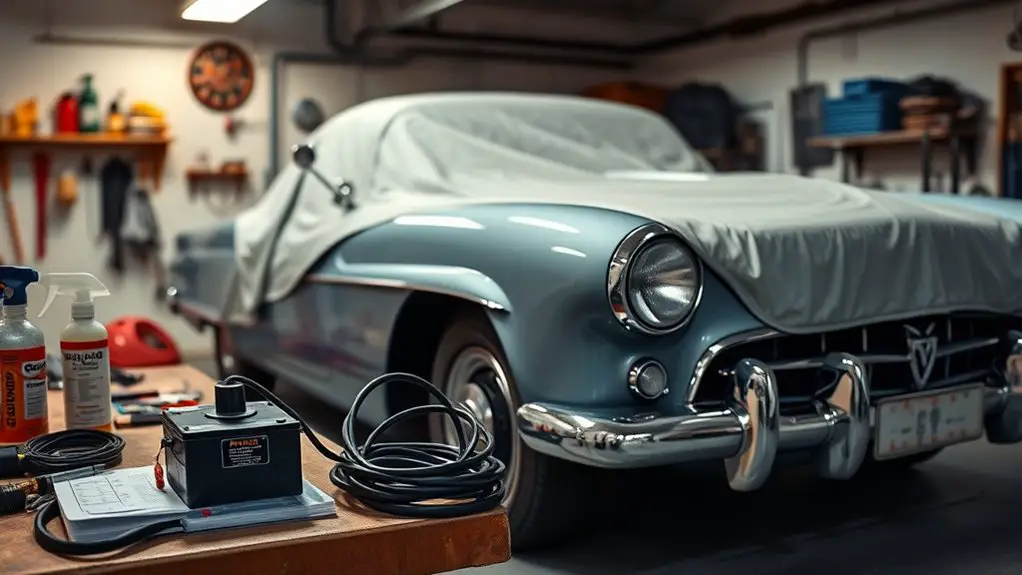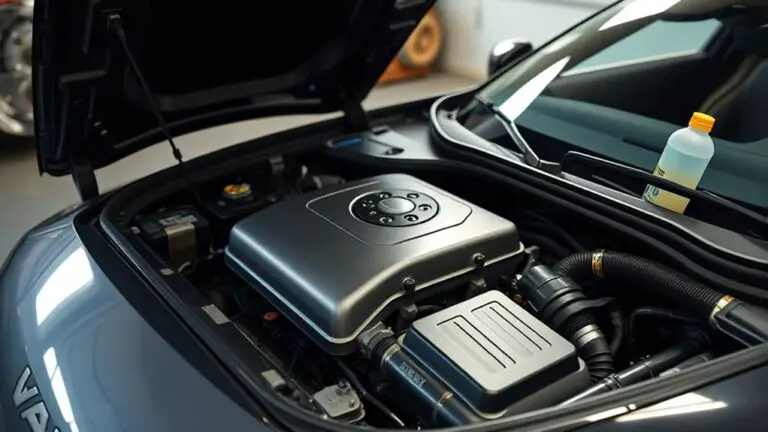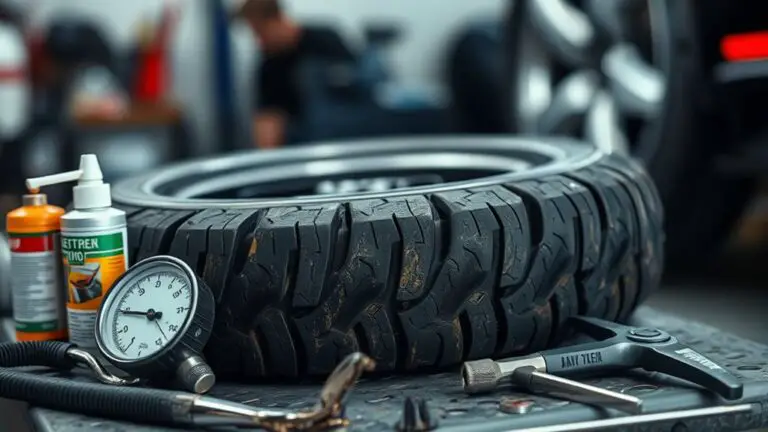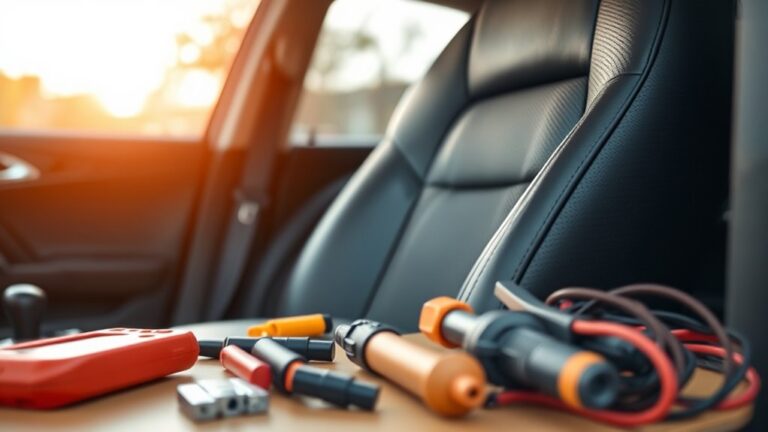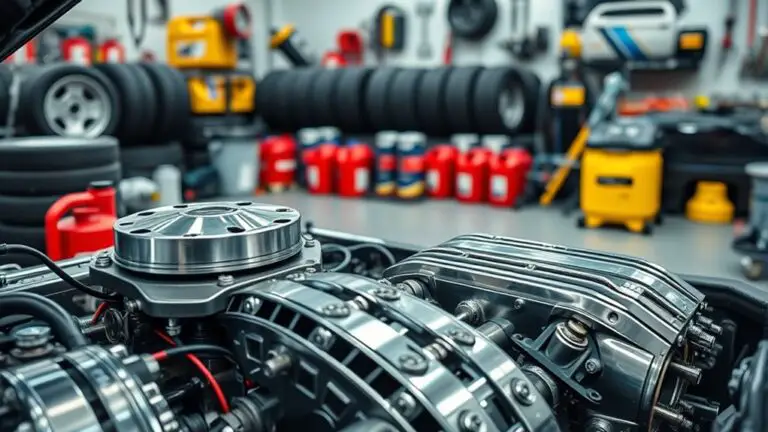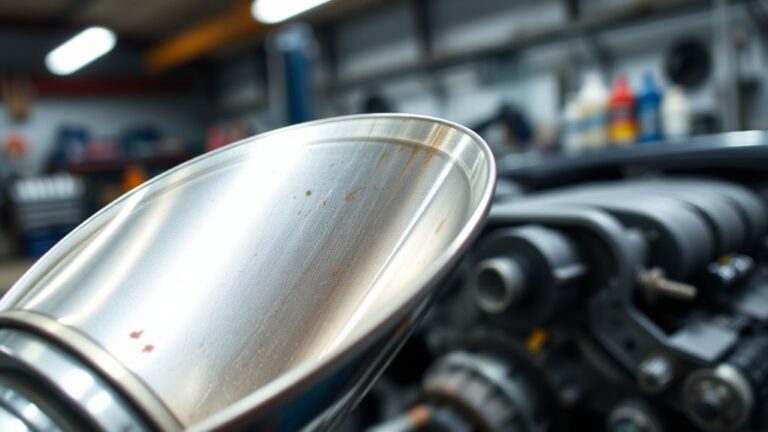How to Prepare Your Classic Car for Long-Term Storage to Avoid Battery Drain Over Winter
To prep your classic car for winter and avoid battery drain, start with battery health: check age, resting voltage, clean terminals, and tight connections. Use a smart charger in maintenance mode, set charging current to 4–6% of capacity, and monitor temp. Consider a trickle-free disconnect or routine trickle charging with clear labeling. Stabilize fuel, run the engine briefly, and store in a dry, ventilated space. For more detailed steps, you’ll uncover practical specifics as you go.
Battery Health and Charging Basics
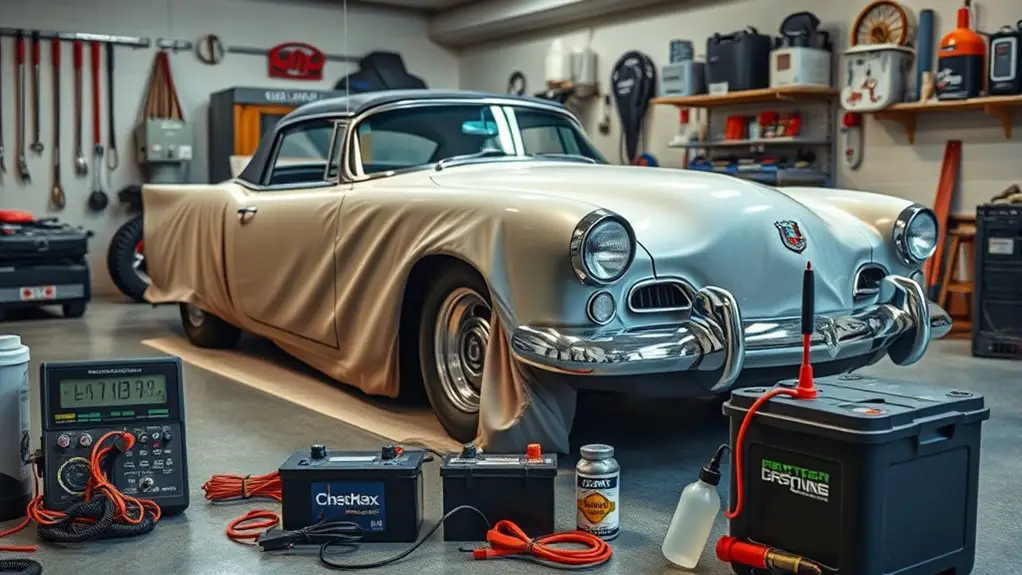
Maintaining battery health is essential for a smooth, worry-free winter storage. You’ll approach this like a diagnostic checklist: verify battery age, measure resting voltage, and inspect terminals for corrosion. Battery maintenance starts with clean, tight connections to minimize parasitic drains. If you’re seeing voltage below ~12.6V with the engine off, plan a controlled charging routine before storage.
Charging techniques matter. Use a smart charger or charger with an automatic maintenance mode that switches to float when loaded. Set charging current to roughly 4–6% of the battery’s capacity for a healthy lead-acid unit; lithium systems may accept higher rates per manufacturer guidance. Avoid fast, continuous high-current charging, which can heat and degrade cells. Monitor temperature; stop if you sense swelling or odor. Disconnect the charger once the resting voltage meets the recommended specification for your battery type. Document cycle dates, voltage targets, health indicators, and any anomalies for your future winter inspections. This disciplined approach preserves reliability and freedom when you return.
Trickle Charge Vs Trickle-Free Disconnect Options
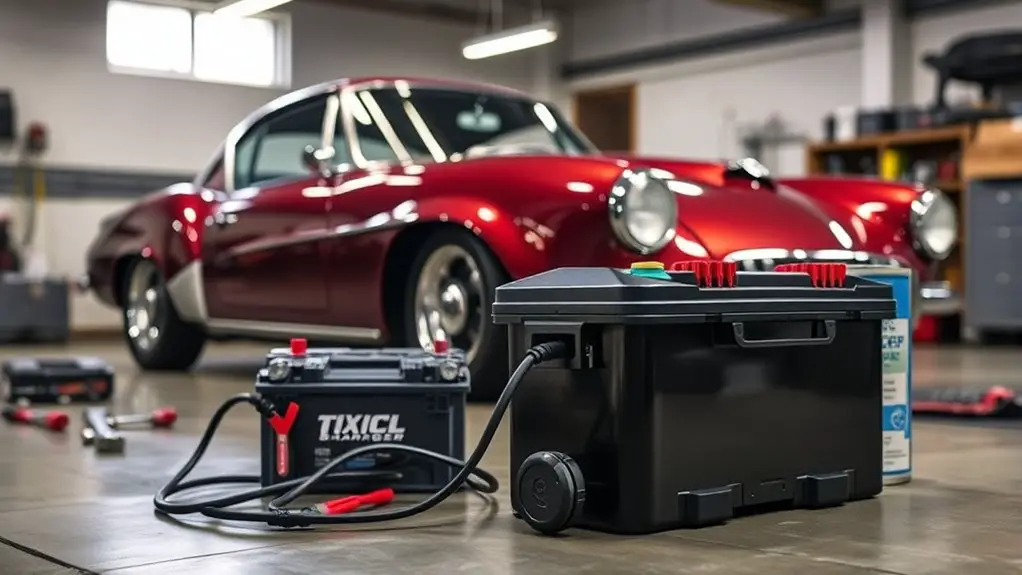
Trickle charging keeps the battery topped off during storage, but you’ll want to monitor charge rate and age to avoid overcharging. A trickle-free disconnect protects the electrical system by eliminating parasitic drain entirely when the car is stored, yet you must guarantee essential systems aren’t left without a stable reference. Compare battery drain risks, charging basics, and practical safety steps to decide which approach suits your car’s battery type and storage plan.
Trickle Charge Basics
For most classic cars, a trickle charger is a small, constant-current device used to keep the battery at its full state of charge without overcharging. You’ll choose from trickle charger types based on amp rating, voltage, and features like desulfation or automatic maintenance modes. Set the charger to a safe float or maintenance voltage appropriate for your battery chemistry, typically around 13.2–13.8 volts for lead-acid. Monitor charging duration to avoid unnecessary heat or gassing, especially in enclosed spaces. Use a quality cord and weatherproof connector if outdoors, and never leave portable chargers unattended for extended periods. Regularly inspect cables for wear, and detach during extreme cold when not needed. This approach balances reliability with freedom, without compromising safety.
Disconnect Benefits
Disconnects offer a practical alternative to continuous trickle charging by removing the battery from the system or isolating it from the vehicle’s electrical draw, preventing parasitic loads and reducing heat buildup in storage. In practice, you’ll evaluate disconnection methods by how completely the circuit is opened and how easily you can restore power. Trickle-free options minimize continual energy consumption and eliminate standby parasitics, preserving battery integrity during months of inactivity. Assess compatibility with your harness, fuses, and remaining loads to avoid accidental re-engagement. The primary disconnection advantages include reduced corrosion, fewer heat cycles, and simplified safety checks before reuse. For long-term storage, plan around battery longevity, ensuring the chosen method remains mechanically secure while accessible for inspection, testing, and reinstallation. Maintain clear labeling and documented procedures for routine follow-up checks.
Battery Drain Comparison
When you’re weighing battery drain under storage conditions, comparing trickle charging to trickle-free disconnects helps you choose reliability over constant power draw. In practice, trickle charging maintains voltage, minimizes sulfation risk, and preserves battery performance over long storage duration. It’s effective if you have stable ambient temps and a monitored charger with proper amp rating. But it keeps the system partially energized, so parasitic draws and charger faults can still nibble away at capacity. Trickle-free disconnects cut power entirely, eliminating drain from the car’s circuitry and chargers, yet risk battery voltage creeping down if the storage environment fluctuates. For maximum reliability, use a cold-weather-rated charger or switch to a reputable disconnect device with a proven, low-leak profile. Balance your choice against expected storage duration and climate stability.
Fuel Stabilization and Engine Protection
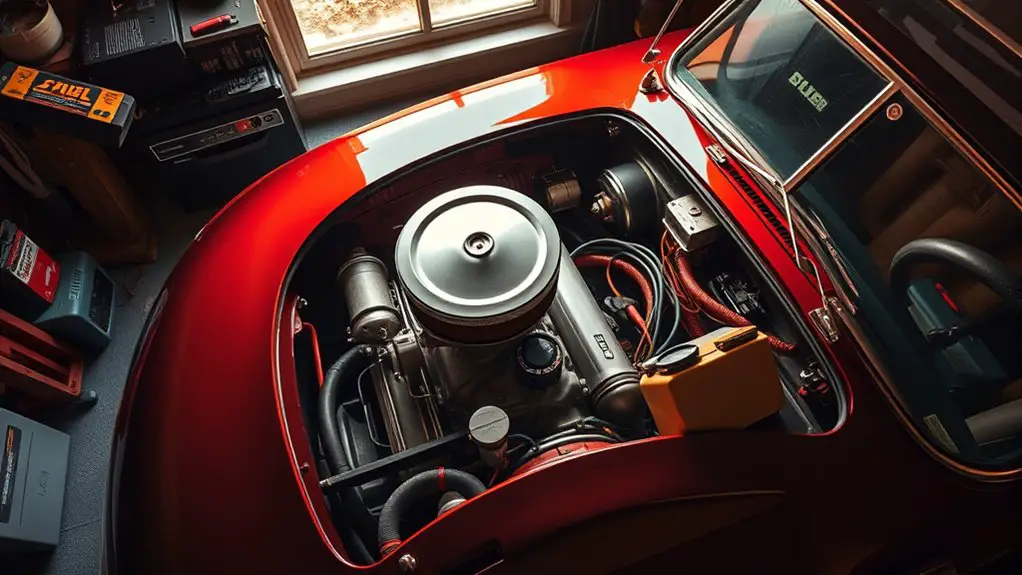
To stabilize fuel and protect the engine during storage, add a fuel stabilizer according to the product’s directions and fill the tank to prevent moisture buildup, then run the engine for several minutes to circulate the treated fuel. You’ll want to confirm the stabilizer is compatible with ethanol blends common in your area. After running, check for any leaks, and inspect hoses and clamps for signs of aging. Use fresh engine oil before storage if you’re not due for a change, because old oil can contribute deposits that complicate startup after winter. Note fuel quality is critical: stabilize fuel to minimize varnish and gum formation that can clog injectors or carburetors. If your car sits idle for months, consider a fuel-system treatment designed for long-term storage to preserve seals. Finally, keep the vehicle in a dry, ventilated space and monitor for corrosion or staining near the fuel lines.
Cleaning, Detailing, and Moisture Control for Storage
Cleaning, detailing, and moisture control start with a clean, dry environment and a methodical approach: wipe down all exterior surfaces with a quality detailer to remove dust and contaminants, then vacuum and thoroughly wipe interior surfaces to prevent moisture buildup from humidity or residual cleaners. You’ll focus on interior cleaning to remove fabric fibers, dashboards, and seams that trap moisture, reducing mildew risk during long storage. Exterior detailing should emphasize paint protection, sealant, and chrome care without aggressive compounds that could harm finishes. Use microfiber, lint-free towels, and dedicated applicators to avoid cross-contamination. Address moisture by sealing gaps, drying floor mats, and using moisture-absorbing desiccants placed away from vents. Inspect seals and weatherstripping for cleanliness, guaranteeing a tight enclosure when covered. Avoid clutter, guarantee adequate airflow where applicable, and run a brief interior air exchange before storage. This approach preserves finish integrity, minimizes corrosion risk, and maintains readiness for spring.
Electrical System Prep and Corrosion Prevention
Electrical system prep for storage starts with a clean baseline: disconnect the battery, inspect for corrosion on terminals, and clean with a contact-safe degreaser before applying a thin layer of dielectric grease. You’ll then reconnect only after confirming clean, tight terminals and no exposed wiring wear. Next, inspect fusible links, relays, and fuses for signs of overheating or corrosion; replace if necessary to prevent parasitic drain. Tie-downs for battery harnesses should be snug but not stressed, with the negative post grounded to chassis to avoid stray voltage. When you’re done, apply corrosion inhibitors to exposed metal surfaces and electrical connectors to deter oxidation during long-term storage. Store components away from moisture pockets, and label any removed parts for quick reassembly. Keep a documented checklist to guarantee electrical maintenance consistency. This approach minimizes corrosion risk while preserving performance, delivering safer, more reliable winter starts.
Environment, Access, and Monitoring During Hibernation
You should set a stable storage environment with controlled temperature and humidity, and establish guardrails to prevent accidental exposure or moisture buildup. Use remote access and monitoring to track conditions, door status, and security alerts without needing to be on-site. Maintain clear safety protocols for access—limit who can enter, verify power stability, and document any anomalies promptly.
Storage Environment Guardrails
Effective storage hinges on a controlled environment, clear access rules, and continuous monitoring during hibernation. You’ll set a stable storage temperature within a narrow band to minimize battery drain and chemical shifts in fluids. If indoor, target a room around 50–68°F (10–20°C) with minimal temperature fluctuation; if outside, insulate the shelter and employ a calibrated heater with a thermostat and backup power. Humidity control matters: keep relative humidity low enough to deter corrosion, ideally 40–60%, while preventing rubber and seals from drying. Enforce restricted access to authorized personnel only, log entry times, and lockout procedures. Install a simple, reliable monitoring plan: a low-power thermometer, a humidity sensor, and alert thresholds that trigger human checks during extended storage gaps. Regularly verify sensors and reset alarms.
Remote Access & Monitoring
Remote access and monitoring during hibernation should be straightforward and reliable: set up a centralized, low-power monitoring system that alerts you to temperature, humidity, and door status deviations without requiring constant attendance.
- remote monitoring: select a battery-powered gateway with cellular or Wi‑Fi backup, logging every event with timestamps.
- access technology: enable secure remote open/lock controls and audit trails; use multi-factor authentication and device whitelisting.
- alerts and recovery: configure thresholds, push/email alerts, and local buzzer fail-safes; guarantee cell coverage and power redundancy for uninterrupted visibility.
Keep cabling tidy, enclosure sealed, and firmware updated; test weekly checks during initiation and after storage repositioning. This approach preserves battery health while empowering you with confident freedom.
Frequently Asked Questions
How Often Should I Rotate the Tires During Storage?
You should rotate the tires every month during storage. This routine relieves flat spots and distributes weight evenly, helping tire pressure stay stable. While you rotate, inspect tire condition for cracks, bulges, or uneven wear, and adjust the tire pressure to spec before reseating. Keep suspension supported and vents clear, and document each rotation. This practice protects stability, prevents drift, and maintains readiness, ensuring safe, ready-on-demand performance when you pull the car back into service.
Will a Solar Panel Trickle Charger Work Long-Term?
A solar panel trickle charger can work long-term, but its effectiveness depends on panel quality, load, and weather. You’ll want a charge controller rated for automotive use to prevent overcharging and wiring that minimizes parasitic drain. If you monitor it, the solar panel effectiveness sustains a healthy battery over winter with safe, steady current. Long term benefits include reduced electrolyte stratification and fewer cold-crank failures. Stay vigilant, install securely, and respect safety guidelines for battery charging.
Can a Storage Blanket Cause Condensation Issues?
A storage blanket can cause condensation issues if temperature swings are sharp or ventilation is poor. Guarantee proper storage conditions by allowing airflow, avoiding airtight sealing, and monitoring humidity to prevent moisture accumulation. Use a breathable cover and position the car off the ground with a dehumidifier or silica gel packs nearby. Check regularly for damp spots and rust risk, and keep the area fire-safe, well-lit, and compliant with safety guidelines for long-term storage.
Should I Disconnect the Battery While Using a Battery Tender?
Yes, you should disconnect the battery if you’re not running the car while the tender is connected, to prevent parasitic drains. A smart approach: connect the tender to the battery directly or via a battery maintenance port, but isolate the negative cable when disconnecting. This enhances battery safety and maintenance. Remember: check electrolyte levels, terminals clean, avoid shorting. Approximately 80% of battery failures are preventable with proper battery maintenance and safe disconnection practices. Freedom lies in cautious, precise handling.
What Are Signs of Hidden Electrical Drain During Hibernation?
Hidden drains show up as parasitic draws you can measure: unexpected battery dip when nothing else runs, interior lights lingering, or modules staying awake. Electrical issues often leak current through accessories, alarms, or incorrect dimming circuits. Use a multimeter on the 12V line to quantify milliamp draw, then isolate circuits one by one. If you detect a draw above manufacturer specs, re-seat connectors, inspect wiring for damage, and address ground faults to prevent safety hazards.

